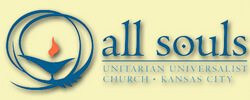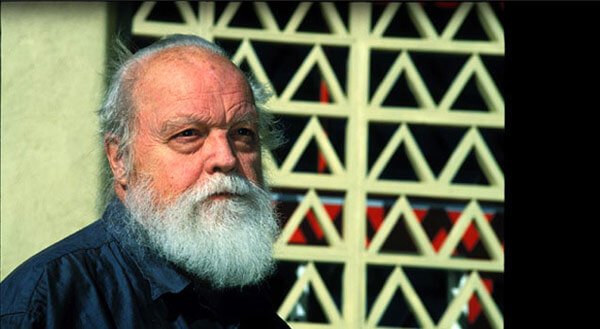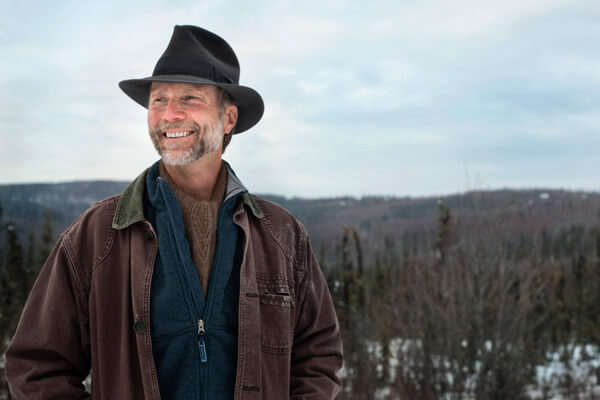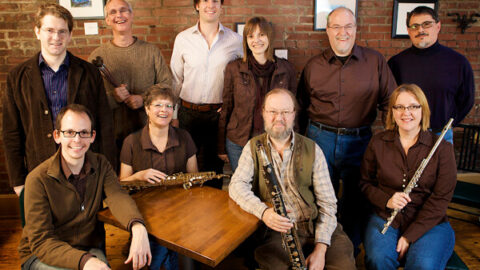 Kansas City’s newEar Contemporary Music Ensemble concluded its 21st season Saturday, May 3 at All Souls Unitarian Church with “Distant Travels”, a concert celebrating the influences of nature and different cultures in music.
Kansas City’s newEar Contemporary Music Ensemble concluded its 21st season Saturday, May 3 at All Souls Unitarian Church with “Distant Travels”, a concert celebrating the influences of nature and different cultures in music.

Dan Coleman described the opening work, his Sad and Ancient Phrases (1999) for violin and piano as a melancholy, nostalgic journey through musical styles from Brahms to today. Fond of writing in standard forms using time honored instrumental combinations, Coleman used Sad and Ancient Phrases to chronicle his journey from his home in New York City to his new home in the Arizona desert. Rippling piano, soaring, long lined violin and a generally tonal outlook give the work a Brahmsian gravity, contrasting nicely with the other works on the program. A strong and vital performance, receiving a hearty cheer from the audience which included the composer.
Lou Harrison’s Varied Trio (1987) is quintessential Harrison, imbued with the spirit of Asia, Indonesian Gamelan and an almost child-like sense of wonder. Scored for violin, piano and percussion in four movements, Veronique Mathieu, (violin) and Robert Pherigo (piano) were joined by Mark Lowery on percussion.

The opening Gending, using violin, piano, vibraphone and gong, directly refers to and imitates the rhythmic structures and sounds of the Indonesian gamelan. All combined to produce a most hypnotic and lyrical performance. Bowl Bells, with Mark Lowery and his battery of water-tuned rice bowls combining with the insistent, repetitive violin pizzicati and percussive knocks on the piano soundboard, charmed the audience with its virtuosity and imaginative color. Overheard at intermission: Lowery’s wife giggling at how they went to every Asian market in town checking out not the price or the color but the sound of the rice bowls for sale.
Elegy, an interlude for violin, piano and vibraphone showed Harrison’s romantic, lyrical side. Lacking from the performers was the needed intensity and pathos and more secure intonation in the high, exposed violin line.
Rondeau in honor of Fragonard, an homage to the French rococo painter Jean-Honoré Fragonard is the most conventional movement in form and sound and also predominately features the violin and piano. A wistful portrait of the facile, graceful art of Fragonard and rococo works in general, this performance could have used just a bit more lyrical grace and style. Fragonard was overall a charming and perfect foil for the final Dance movement that took us from 18th century France to a rowdy jazz hall, replete with banging baking pans, pulsing tambourine and driving pizzicati. Think of Dance, at a brief two minutes, as an “end theme” at the conclusion of a show.

John Luther Adams has an innate feeling for the sounds and music of nature. Much of his music, including the 2014 Pulitzer Prize winning “Become Ocean,” is a reflection of the light, sound and color of Alaska, where he has lived and taught for many years. Songbirdsongs (1974-1980) is an early work yet one can already sense Adam’s fascination with wildly beautiful, sometimes overwhelming musical-visual landscapes.
Scored for a varying ensemble of piccolos, flutes, ocarinas and percussion, Songbirdsongs does not have a fixed score. Instead each piece consists of a set of written instructions inspired by the birds’ habitats and habits plus a series of un-ordered musical phrases derived from the bird’s distinctive call. The format allows the performers to interact spontaneously as do the birds in nature, thus no two performances are exactly alike. The newEar ensemble was spread around the auditorium, flutes to the side and percussion fore and aft. Lyra Pherigo and Adrienne Garstang on the flutes were flawless in tone and execution as were Mark Lowry, Nick Petrella and William Shaltis on percussion.
Songbirdsongs, as is its avian inspiration, is never static but is elementally flowing and unpredictable. And that is what this performance lacked, not so much musical technique, but a natural flow and excitement in its presentation. The movements are short and frankly can sound about the same if the performers are not careful in how they interpret the melodic cells. The ensemble’s long pauses between each evocation jarred the audience back to the stark reality that we were in an auditorium, not the deep woods of Alaska.
The most successful movements were the opening Wood Thrush with the soft and consistent wooden wind chimes evoking the rustling of trees and limbs underpinning the ecstatic calls of the thrush, mallet percussion commenting and echoing. “Mourning Dove” with its ocarinas evoking the muffled, haunting sounds of doves, owls and loons in a foggy wetland. Finally, “Meadow Dance” effectively used the rustle of maracas to evoke a meadow teaming with insect life. Perhaps if the ensemble had captured the shimmering ecstasy of the final section Strange Birds Passing the overall performance would have been more satisfying, but it came out as just another section of the work, not a summation and celebration of what came before. The Callithumpian Consort (Mode #240) recording I used to familiarize myself to the work, sounded very similar to this performance, but was somehow more satisfying a listening experience. Songbirdsongs, perhaps, is one of those compositions best heard and not seen.
























